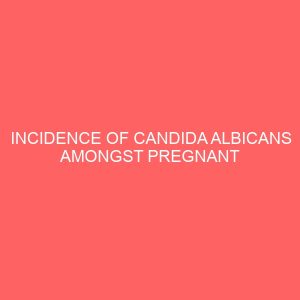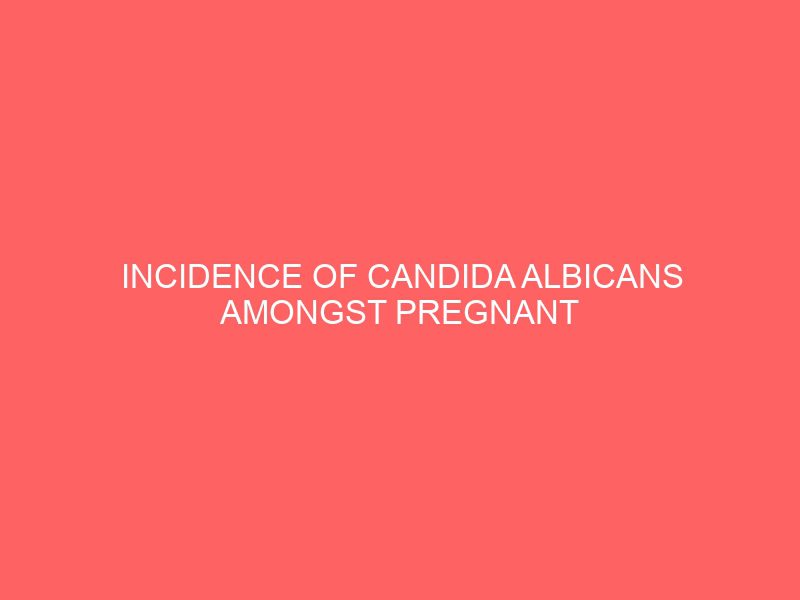Description
CHAPTER ONE
1.0 INTRODUCTION AND LITERATURE REVIEW
1.1 INTRODUCTION
This research is on Incidence of candida albicans amongst pregnant women/owerri metropolis and non-pregnant. Candida are small, oval yeast measuring 2-4 mm in diameter. It causes a disease condition known as candidiasis. Candidiasis is considered an opportunistic and a sexually transmitted infection. It constitutes great health problems to many women. More so, there has been rampant complaints of pregnant and non-pregnant women who attend clinics at Federal Medical centre and general Hospital Owerri about vagina itching and discharge. Being that this is a common symptom of candidiasis, it has become expedient to establish the incidence of this microorganism amongst the population of these women.
In the history of medicine and scientific exploration, new discoveries are made on a regular basis; in fact, many people devote their lives to the identification and treatment of disease. When these disease are discovered, it is often assumed that they are new. These disease might well have been with us for many year. (Marshall et al: 1983).
Although, the term infection and diseases are sometimes used interchangeably, they differ somewhat in meaning. Infection is the invasion or colonization of the body by pathogenic microorganisms, which disease occurs when an infection results in any change from a state of health.
Disease is an abnormal state in which part or all of the body is not properly adjusted or is not capable of carrying on its normal function.
An infection may exist in the absence of detectable disease. Once a relationship between the normal microbiota can benefit the host by preventing the overgrowth of harmful microorganisms, a phenomenon called antagonism (Tortora et al; 1995).
Microbial antagonism involves competition among microbes, one consequence of this competition is the host against colonization by potentially pathogenic microbes by competing for nutrients, producing substances harmful to the invading microbes, and affecting conditions such as PH and available oxygen. When this balance between the normal microbiota and pathogenic microbas is upset, disease can result. For example, the normal bacterial microbiota of the adult human vagina maintains a local PH of 3.5 to 4.5. the presence of the normal microbiota inhabits overgrowth of the yeast Candida albicans, which cannot grow under these conditions and is normally present in small numbers in the vagina. If antibiotics, excessive douching or deodorants eliminate the bacteria population, the PH of the vagria reverts to nearly neutral and Candida albicans can flourish and become the dominant microorganism there.
Candidasis is a disease caused by yeast-like fungus, Candida albicans; that often grow on mucous membranes of the mouth, intestinal tract, and genitor-urinary tract. Infections are usually a result of opportunistic overgrowth when antibiotics or other factors suppress the competing microbiota. It is responsible for occasional cases in non-gonococcal urethritis in male and for vulvovginal candidiasis which is the most common cause of vaginitis. About 75% of all women experience at least one episode.
The lessons of vulvovaginal candidiasis resemble those of oral thrush but produce more irritation, severe itching, thick yellow cottage, cheese-like discharge, and a yeasty odour. Candida albicans is an opportunistic pathogen. Predisposing conditions include use of oral contraceptives and pregnancy. Which causes an merease in glycogen in the vagina. Diabetes, and treatment with broad-spectrum antibiotics are also associated with the occurrence of candida albicans and vaginitis, (Tortora et al; 1995).
Candida albicans and its close relatives account for nearly 80% of nosocomial fungi infections in general, (Talaro, 2008).
The Federal Medical Centre and general Hospital Owerri have both ante-natal and out-patient units; where they rouser different services to patients. Therefore provide a fetile ground for an investigation such as this.
1.1 OBJECTIVES OF THE STUDY
The objective of this study include:
a. Detection of Candida albicans in women attending the clinics
b. To know the age group mostly affected
c. To know the rate (incidence) of Candida infection in Owerri urban.







